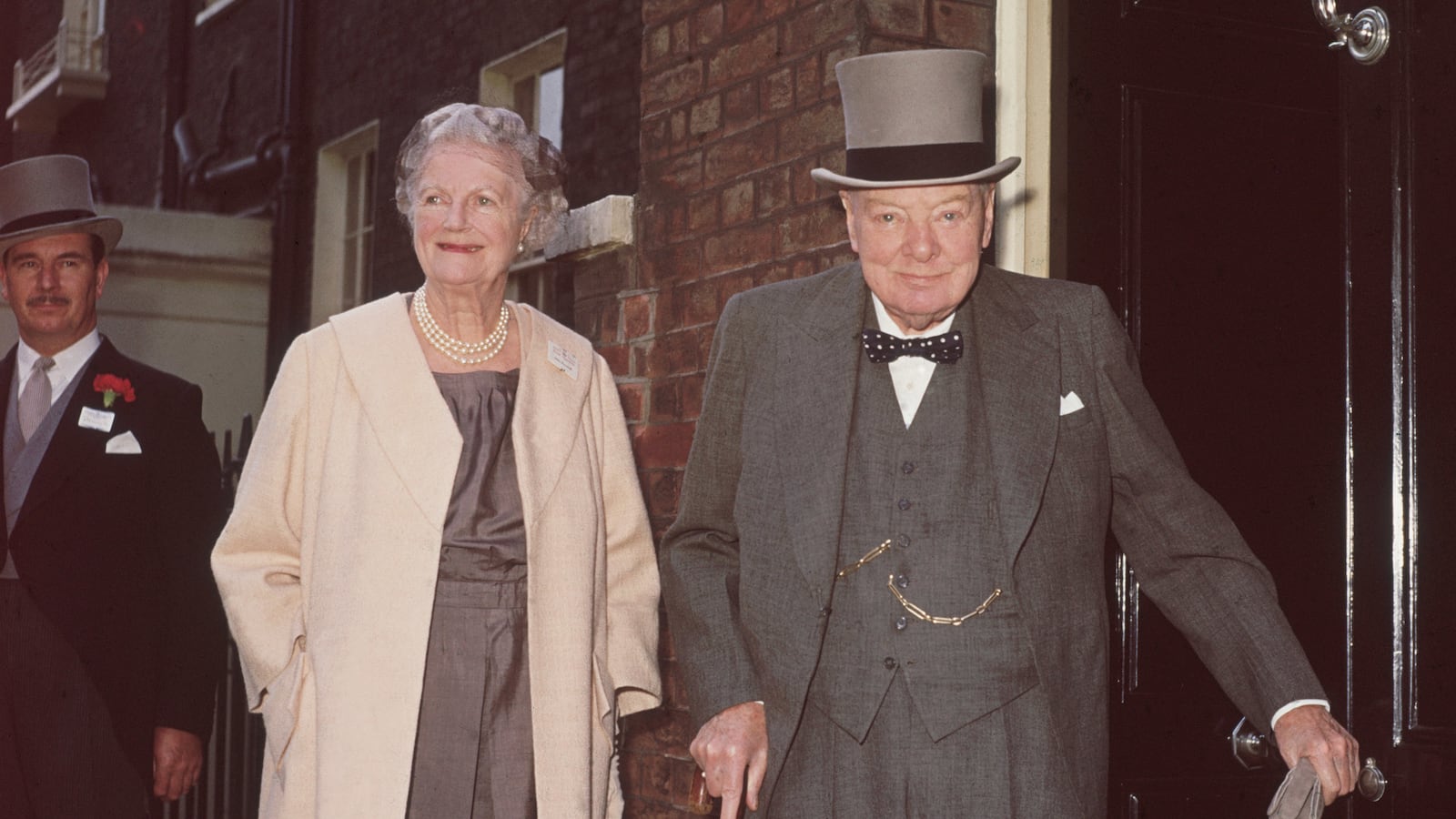Clementine Churchill is traditionally seen as the archetypal devoted wife, in her case of British Prime Minister Sir Winston Churchill throughout their fifty-seven year marriage.
The legendary wartime British Prime Minister’s dependency on his wife is up there with the outsized cigar and the “We shall fight on the beaches” proclamation in being a time-honored Churchillian cliché.
Clementine Ogilvy Spencer-Churchill has always been portrayed as the ideal British Conservative leader’s wife--aristocratic and loyal, dutiful and docile.
Only recently a new Churchill biopic was announced--starring Brian Cox as the Great Man--and the announcement in trade publication Screen Daily portrayed Clementine in the role of sturdy anchor smoothing the choppier waters sailed by HMS Winston.
“Only the unflinching support of his unflappable wife Clementine can halt the iconic leader’s physical and mental collapse,” read the announcement.
Certainly Clementine steadfastly supported her husband during his triumph over the Nazis during the Second World War, his two stints as British Prime Minister, and his decade of political wilderness in the 1930s.
But historian and journalist Sonia Purnell’s fascinating new biography Clementine: The Life of Mrs. Winston Churchill reveals the reality to be much more complex than the legend.
Clementine might have been “unflinching” and “unflappable,” as per Screen Daily, but if Purnell’s tome is anything to go by, Winston Churchill was as much politically—as well as personally--indebted to his wife.
Purnell, whose previous tome was a lively biography of colorful London Mayor and Churchill biographer Boris Johnson, writes, “Her power and influence--and the results she achieved--would be unthinkable for a Prime Ministerial spouse today.”
Take what many believe to be Winston Churchill’s finest hour: the Normandy D-Day landings of June 1944. In addition to being supportive, Mrs Churchill gave strategic advice according to her biographer: “Earlier that evening, Winston and Clementine had discussed the prospects of the gambit’s success, at length and alone, over a candlelit dinner.”
The historical stereotype of Clementine Churchill being a conventional Tory wife is undermined by the fact she wasn’t even a Tory.
Like her husband, whose political conversions are the stuff of political legend, Clementine began life as a liberal but unlike Winston, she stayed liberal (although she stopped voting for her preferred party out of loyalty to her husband’s career).
Tories, she argued in her youth, “are ignorant, vulgar, prejudiced. They can’t bear the idea of the lower classes being independent and free.”
She might not be depicted by Carey Mulligan and co. in the new film Suffragette but Purnell records, “Clementine’s belief in the cause of women’s suffrage never faltered and she attended several major court cases against members of the movement.”
Purnell considers her a feminist before the term gained wider currency, although her support for women to be given the right to vote did not prevent her from likely saving Winston Churchill’s life in 1909 by leaping and pulling him back by his coattails when a suffragette pushed her husband--who at time opposed voting equality--toward a moving train.
Like that of her husband, Clementine Churchill’s childhood was impeccably aristocratic, yet emotionally unstable.
Her mother Lady Blanche, “prone to sexual intrigue” writes Purnell, was divorced by her husband Colonel Henry Hozier when Clementine was six.
Questions about her paternity remain to this day. One prominent paternal candidate is Blanche’s brother-in-law Bertie Mitford, grandfather of Nancy Mitford. She had a capricious upbringing: her mother decided to spend a year living around the fish markets of Dieppe, France, reputedly choosing her living quarters on the toss of a coin.
The announcement of Clementine’s wedding to Winston was looked down by many in British high society; former British Prime Minister Lord Rosebery gave the marriage six months.
According to Purnell, Churchill oddly wrote to his mother seeking advice about sex on his wedding night. He subsequently wrote a letter of thanks her for her advice in that department and disclosed he and his new wife had “loved and loitered.”
Clementine and Winston went on to have five children, most of whom endured bad marriages and battles with alcoholism.
Winston Churchill once claimed he and his wife had “lived happily after”. Far from it. Their union was far from an idyllic and more like…a real marriage.
The arguments between them were titanic. Purnell quotes a staff member saying of Clementine Churchill: “When her nerves were stretched, she sometimes turned on Winston with vitriol in her voice and the flashing eyes of a Fury.”
Purnell uncovers the startling claim of Winston and Clementine that “she may have spent up to 80 percent of their marriage without him.”
The late Pamela Harriman, who had a disastrous marriage to the pair’s son Randolph Churchill en route to becoming Bill Clinton’s US Ambassador to France, even implies divorce was a distinct possibility: “There might have been many times, I’m sure in the twenties and thirties, when she could have left him and nobody would have blamed her.”
Purnell doesn’t downplay their co-dependency, dubbing them “the ultimate coalition”. But even in their twilight years, “as he [physically] weakened, she became more dictatorial.”
Like JFK’s marriage, it was a union that transcended emotional volatility.
Purnell also compares Clementine to Jacqueline Kennedy in the style stakes: “Clementine pushed the boundaries in so many ways, not least as a style icon way before Jackie Kennedy was on the scene doing the same,” she notes.
“Clementine's pared down sleek and slim outfits, her top-button leopard-skin coats, her turbans and jewellery were noted by a nation and furiously copied. In fact, her straight-down coats with a button in the collar became widely known as ‘Clementines’ long into the Sixties. Even her interior decor was trend-setting.”
It’s often overlooked that Clementine was hugely popular in America. She formed a tight bond with Eleanor Roosevelt which helped smooth over the chilliness that existed between Mrs. Roosevelt and Winston Churchill and herself and FDR.
“Eleanor and Clementine may have looked different with contrasting personal styles,” says Purnell, who herself was invited by the present-day Roosevelt clan to speak at the FDR Library at Hyde Park recently. “But after a while they found they had so much common ground and formed a bond of trust and mutual admiration.”
“Of all the influences in his life she was the most woefully unappreciated but in truth she was the strongest,” Purnell concludes about Clementine. Her book may leave you thinking she’s one of the most underrated, complex women in British history and that her husband’s achievements and extraordinary life must not be allowed to shrink her existence any longer.
One assumption the new biography doesn’t seek to revise is the strength of the love which existed between Winston and Clementine Churchill which enabled their relationship to soar above the challenging tribulations arising from two headstrong, uncompromising marital partners.
Following a British state funeral, Winston Churchill was buried at a parish church in Bladon, Oxfordshire in January 1965. Clementine Churchill bid her farewell with the words: “I will soon be with you again.” Nearly 13 years later she was.
Clementine by Sonia Purnell is published by Viking






